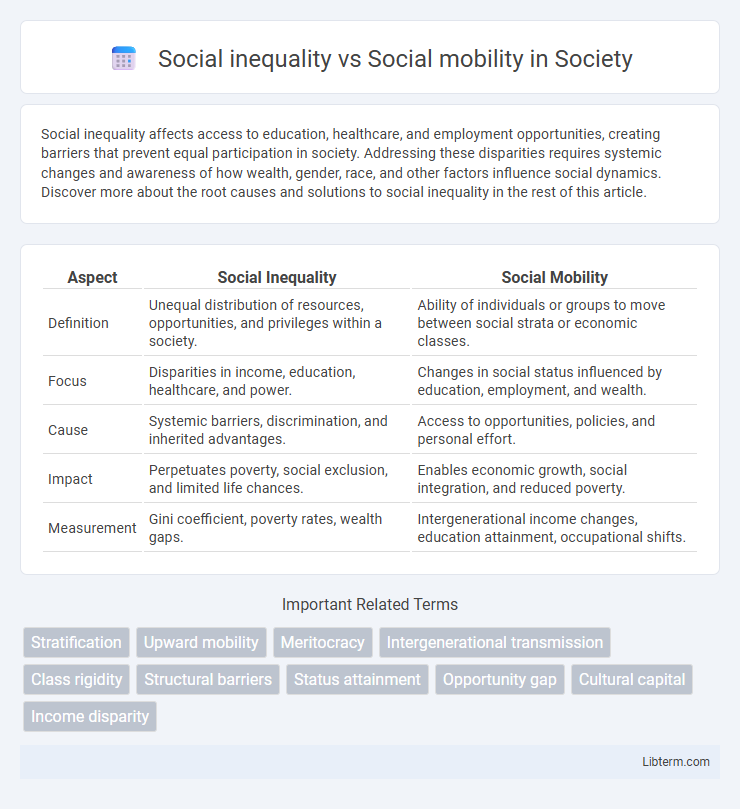Social inequality affects access to education, healthcare, and employment opportunities, creating barriers that prevent equal participation in society. Addressing these disparities requires systemic changes and awareness of how wealth, gender, race, and other factors influence social dynamics. Discover more about the root causes and solutions to social inequality in the rest of this article.
Table of Comparison
| Aspect | Social Inequality | Social Mobility |
|---|---|---|
| Definition | Unequal distribution of resources, opportunities, and privileges within a society. | Ability of individuals or groups to move between social strata or economic classes. |
| Focus | Disparities in income, education, healthcare, and power. | Changes in social status influenced by education, employment, and wealth. |
| Cause | Systemic barriers, discrimination, and inherited advantages. | Access to opportunities, policies, and personal effort. |
| Impact | Perpetuates poverty, social exclusion, and limited life chances. | Enables economic growth, social integration, and reduced poverty. |
| Measurement | Gini coefficient, poverty rates, wealth gaps. | Intergenerational income changes, education attainment, occupational shifts. |
Understanding Social Inequality: Definitions and Dimensions
Social inequality refers to the uneven distribution of resources, opportunities, and privileges across different social groups, influenced by factors such as class, race, gender, and education. It manifests in various dimensions, including economic disparities, access to healthcare, educational attainment, and political representation. Understanding these dimensions is crucial for analyzing barriers to social mobility, which defines the ability of individuals or groups to move within or between social strata.
The Concept of Social Mobility Explained
Social mobility refers to the ability of individuals or groups to move within a social hierarchy, often measured by changes in income, education, or occupation across generations. It contrasts with social inequality, which highlights persistent disparities in wealth, status, and access to resources that limit upward mobility for marginalized populations. Understanding social mobility involves analyzing both structural barriers and opportunities that shape how easily individuals can improve their socioeconomic position.
Historical Context: Evolution of Social Hierarchies
Social inequality and social mobility have evolved through distinct historical contexts shaped by rigid hierarchies such as caste systems, feudalism, and class structures that limited upward movement. Industrial revolutions and educational reforms introduced mechanisms for increased social mobility, challenging entrenched inequalities. Despite progress, residual effects of historical social stratification continue to influence access to resources and opportunities in modern societies.
Root Causes of Social Inequality
Social inequality stems primarily from disparities in access to quality education, economic resources, and social networks, which create entrenched barriers for marginalized communities. Structural factors such as systemic racism, discriminatory policies, and unequal labor market opportunities perpetuate these disparities across generations. Addressing root causes requires targeted interventions that dismantle institutional biases and bolster pathways for upward social mobility.
Factors Influencing Social Mobility
Social mobility is significantly shaped by factors such as education access, economic background, and social networks, which determine an individual's ability to change social status. Structural inequalities in income distribution, racial discrimination, and unequal opportunities within labor markets create barriers to upward mobility, reinforcing social inequality. Government policies on taxation, education funding, and affirmative action also play a critical role in either promoting or hindering social mobility across different demographic groups.
Impact of Social Inequality on Economic Opportunity
Social inequality significantly restricts economic opportunity by limiting access to quality education, healthcare, and professional networks for disadvantaged groups. Persistent income disparities and systemic barriers reduce upward social mobility, trapping individuals in low-income brackets across generations. Addressing these inequalities is essential to fostering a more inclusive economy and enabling equal chances for financial advancement.
Education's Role in Social Mobility
Education serves as a critical driver of social mobility by equipping individuals with skills, knowledge, and credentials necessary to access better employment opportunities and higher income levels. Social inequality often manifests in unequal access to quality education due to factors such as socioeconomic status, geographic location, and systemic discrimination, limiting upward mobility for disadvantaged groups. Targeted policies aimed at improving educational equity, including early childhood programs, scholarship initiatives, and inclusive curricula, can significantly enhance social mobility and reduce entrenched social disparities.
Policy Approaches to Combat Inequality and Boost Mobility
Policy approaches to combat social inequality and boost social mobility include targeted education reforms, affordable housing initiatives, and equitable access to healthcare services. Governments often implement progressive taxation and social welfare programs to redistribute wealth and provide a safety net for disadvantaged populations. Investing in workforce development and inclusive economic policies also enhances opportunities for upward mobility across different social strata.
Measuring Social Mobility: Global Comparisons
Measuring social mobility involves analyzing intergenerational income elasticity, education attainment, and occupational shifts to assess individuals' ability to improve their socioeconomic status compared to their parents. Global comparisons highlight significant disparities, with countries like Denmark and Canada exhibiting high social mobility, while others such as the United States and Brazil show persistent social inequality and lower upward mobility rates. These metrics reveal how social policies, economic structures, and educational access directly influence the capacity for social advancement across different societies.
Bridging the Gap: Strategies for a More Equitable Society
Bridging the gap between social inequality and social mobility requires targeted policies that enhance access to quality education, affordable healthcare, and equitable economic opportunities. Implementing progressive taxation, investing in community development, and promoting inclusive workforce initiatives create pathways for marginalized groups to improve their socioeconomic status. Data shows that societies with higher social mobility exhibit lower income disparities and stronger social cohesion, underscoring the importance of systemic reforms to achieve greater equity.
Social inequality Infographic

 libterm.com
libterm.com